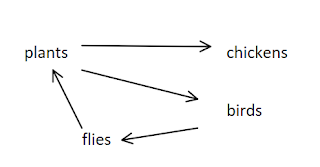A producer
Plant the creates seeds
The habitat of this plant is simple. It creates by itself at the corner of Carney, surrounded by smaller, by smaller plants with the same job. This plants seems to flourish the most of all the plants in it's personal habitat.
A primary consumer
Chicken
The chickens live on our free ranged garden, eating various vegetation and flourishing in all of their functions.
Secondary Consumer and Tertiary Consumer
Human
The people roam around Bellarmine, eating whatever they want.
Decomposer
Fly
The flies fly around the entire campus, feeding on everything and dominating the campus. They mostly eat feces, food from the cafeteria, and corpses.
Herbivore
Honey Bee
They live in a bee habitat that is located in the garden.
Carnivore
Fly
The flies fly around the entire campus, feeding on everything and dominating the campus. They mostly eat feces, food from the cafeteria, and corpses.
Omnivore
Human
The people roam around Bellarmine, eating whatever they want.
Threatened Species
Honey Bees
They live in a bee habitat that is located in the garden.
Endangered Species
Chicken
The chickens live on our free ranged garden, eating various vegetation and flourishing in all of their functions.
Non-native species
Humans
Although humans only migrated to BCP in the 1800s, humans now roam around Bellarmine, eating whatever they want.
Pollution Source
Car
All of the cars are located in the various parking lots. They pollute the whole environment.
Discussion Questions:
1. Environmental science is the over arching study of life sciences on Earth and their environments while ecology is the individual study of organism's interactions with one another in their specific environments. For example, environmental science at BCP is studying everything, including ecology, the meteorology, the seismology, and the geology. Meanwhile, ecology is simply what we studied today.
2. The garden is a population that thrives using many biotic and abiotic factors. It has plants that use many abiotic factors including the sun, the carbon dioxide in the air, and the soil. Additionally, the chickens eat those plants, thus utilizing the biotic factors that are surrounding them. Then, the chickens poop out what they ate and the plant uses it.
3.
4. The most endangered species on campus are the chickens in the garden. Because there is only a couple of chicken. It is scary because if only one or two die, there are none left to reproduce. Additionally, the bees are threatened because the do not have much flowers surrounding them. Once this source of life is gone, they will die off.
5. Pollution is the addition of unnatural masses to an environment. Cars, of course, add gases to Bellarmine with all of the emissions. That is the main pollution source on campus.














